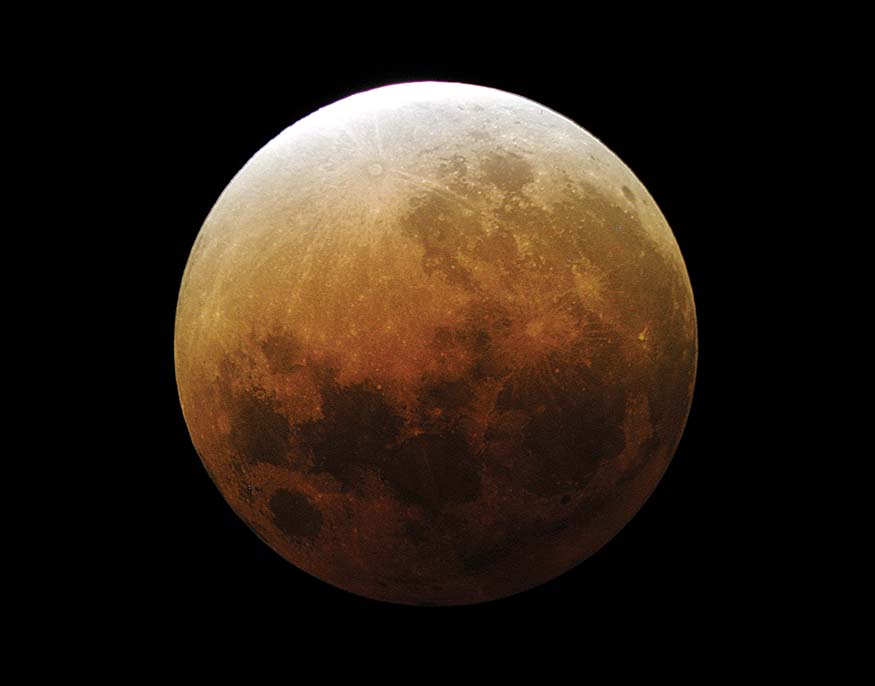
BEAUTY: 
BRAGGING RIGHTS: An amazing sight
HOW EASY IS IT TO SEE? Just look up
TYPE: Special event
DISCOVERED: Known since antiquity
In contrast to the shock and awe of a solar eclipse, a total eclipse of the moon is a calmer affair. Common enough and consigned to the dead of night, many people are happy to sleep through them. But their beauty should not be underestimated. The moon’s ruddy glow, high in the sky, makes the night feel otherworldly, and the unhurried pace gives you a chance to consider and reflect.
You might consider, for example, that this astronomical event is happening on two worlds at the same time: the Earth is seeing a lunar eclipse, but the moon is witnessing a solar eclipse. As you watch the Earth’s shadow cross the face of the moon, think about what the moon is seeing.
In 1969, four months after Neil Armstrong’s historic journey, the crew of Apollo 12 were on their way back from the moon when their spaceship passed through Earth’s shadow. From their perspective, they saw a solar eclipse caused by the Earth! Lunar module pilot Alan Bean reported that “the atmosphere is illuminated completely around the Earth.” They could see a dark Earth, surrounded by a ring of light. It was a marvelous sight never before seen by any humans.
Consult the table on the next page for a list of upcoming lunar eclipses visible from North America. The upcoming January 19, 2019, eclipse looks particularly good, with a full hour of totality.
WHAT YOU MIGHT SEE THROUGH AMATEUR EQUIPMENT
A lunar eclipse involves three distinct phases. It starts with the penumbral phase, in which the moon begins to darken all over. This occurs because the Earth has begun to cover the sun, beginning to darken the face of the moon, but every part of the (sun-facing) moon can still see some bit of the sun.
An hour or more later, you’ll see a chunk of the moon disappear. Now we’re in the partial phase, when at least a part of the moon is fully obscured by the Earth’s shadow.
Over the next hour or so, the moon will gradually disappear until the Earth’s shadow covers the entire moon. This is totality, when every part of the moon we can see is experiencing a total eclipse of the sun.
After totality you’ll see the phases in reverse, and you’ll be left once again with the bright and shiny full moon.
You can watch a lunar eclipse with just your eyes—there’s no need for special glasses, binoculars, or telescopes. Nevertheless, the leisurely pace makes this an excellent time to try astrophotography. Even an average telephoto lens can capture the partial or total phases of the eclipse. If you have a telescope, you can usually just put a digital camera right up to the eyepiece to take a photo.
Upcoming Total Lunar Eclipses in North America
• January 31, 2018
• January 21, 2019
• May 16, 2022
• November 8, 2022
• March 14, 2025
Observe your surroundings. Take note of your surroundings before the eclipse starts. With the full moon overhead you’ll see everything illuminated in bright light. Look again during totality and notice how the reddish color changes your perspective.
Watch the Earth’s shadow. In the partial phase you’ll see a round bite taken out of the moon—that’s the Earth’s shadow. Try to imagine how big the whole circle of the shadow must be. That’s the size of the Earth compared to the moon.
Totality. Something strange happens toward totality: the dark part of the moon turns red. What’s going on? Imagine that you’re standing on the moon. You can see that the Earth has completely covered the sun.
But the Earth has an atmosphere! Sunlight from behind the Earth gets bent by its atmosphere and makes its way to the moon. The refracted light is red, just as the sun is when you see it at sunset or sunrise. If you were on the moon, you’d see an Earth surrounded by a ring of fire.